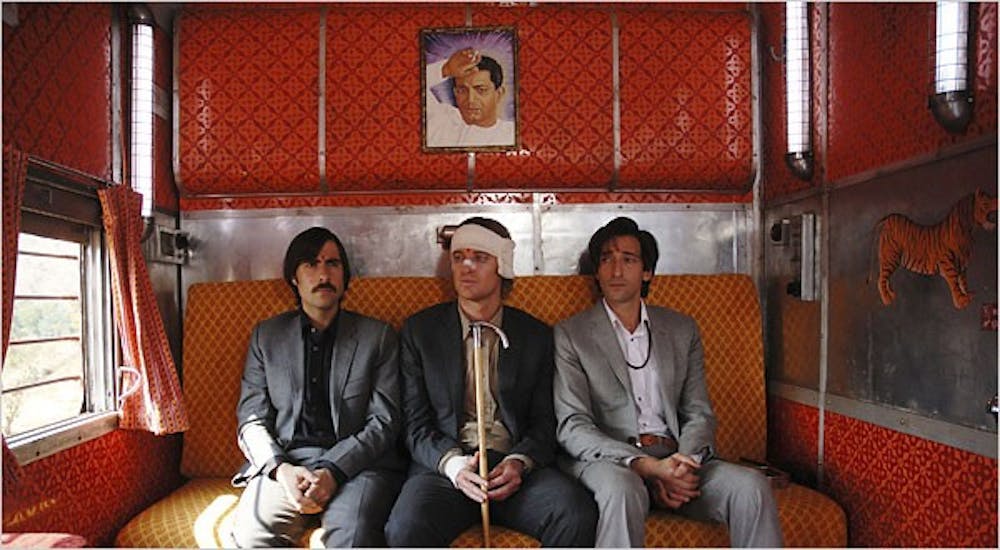GRADE: B-
Wes Anderson usually makes films that feel like they take place inside snow globes: tiny, fictitious, Technicolor worlds that have virtually no reference points to the outside world.
His 2001 opus, “The Royal Tenenbaums,” was set in a surreal, bubblegum-and-candy-colored vision of New York, but all the locations, such as the family’s residence at 111 Archer Ave., or the 375th Street YMCA, are imaginary. His fifth and latest film, “The Darjeeling Limited,” which opens at AMC Georgetown, Landmark Bethesda and Landmark E Street tomorrow, finds Anderson shattering this glass dome and shaking out his troupe of players in, of all places, India. The results are mixed.
The film follows the Whitman brothers (Anderson regulars Owen Wilson and Jason Schwartzman, along with Adrien Brody) along their “spiritual journey” across India in a rickety train called The Darjeeling Limited. The three have not spoken since the death of their father a year before, and their mother (Angelica Huston) has moved to a small village in the Himalayas to become a nun. Though he collaborated on the script for the first time with Schwartzman and Roman Coppola, the eccentricities of the plot are traditional Anderson fare.
In the beginning, the brothers Whitman are hopelessly and unabashedly Western. They wear expensive suits, tote around retro Louis Vuitton luggage (or sometimes have the locals tote it around for them) and seem almost completely disinterested in Indian culture. While the three of them kneel down to pray at an ornate temple, they bicker and Peter (Brody) gets up in a huff and announces, “I’m gonna go pray at that other thing over there.” The brothers’ disregard shouldn’t be mistaken as Anderson’s ethnocentrism though; it’s definitely meant to be a playful joke at the characters’ expense.
Visually, “Darjeeling” is Anderson’s most stunning work yet. Dipping into a palette of bold teals, deep-sea blues and mustard yellows, he crafts nearly every shot in the film as though he were trying to set the example for a future “Intro to Film” textbook’s chapter on framing. Anderson’s cinema is a pastiche of varied influences. Much has been written about his inspiration from the French New Wave Cinema of the early 1960s. Anderson’s films (especially “Rushmore”) have yielded countless comparisons to Fran?ois Truffaut, but his experimentation with color is pure Godard. Nearly every frame illustrates the meticulous attention to detail that has become a hallmark of Anderson’s aesthetic. The screen is always overflowing with beautiful and interesting things to look at. But maybe that’s the problem.
Though the characters in “Darjeeling” go through notable internal changes by the film’s end, the emotional moments are less pointed than they were in Anderson’s previous works. His earlier scripts had an Evelyn Waugh-like knack for adroitly embedding humor inside of personal catastrophe, often within a single line of dialogue.
Anderson’s attempts to write these moments into the “Darjeeling” script sometimes feel contrived. The entire film is so precisely staged and thoroughly stylized that the characters have very little room to breathe. The shots are too crowded with other elements and compete with the dialogue for the viewer’s attention. As a result, the character development and the emotional weight of the film sometimes suffer.
Still, “Darjeeling” boasts quite a few moments that make it worthwhile and make Anderson worthy of the cultish, auteur-like respect that he receives. Francis (Wilson) sports bandages all over his head from a mysterious accident, and in one long, brilliant shot reflecting the trio standing at a bathroom mirror, he slowly removes them as his brothers cringe. After staring at his grotesque scars for a few moments, Francis says, “I guess I’ve got some more healing to do.” The moment twangs with even more poignancy given Wilson’s recent troubles.
Up until now, the settings of Anderson’s films have been finely crafted miniature worlds that heighten the delightful absurdity of his characters. It is surprising, then, that “The Darjeeling Limited” fares much better when the filmmaker drops his characters into the sweeping expanse of the Indian countryside. The first half of the film feels clunky because Anderson uses the claustrophobia of the train as a spatial crutch; it almost seems as though he feels that they will cease to be Wes Anderson characters if they’re left out in a realistic, undefined space for too long. However, Anderson’s quirks shine brightest in moments when he loosens his control a bit. He remains one of the most interesting and talented contemporary U.S. filmmakers, but hopefully, he’ll give his future characters a little more breathing room.





